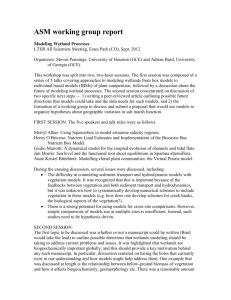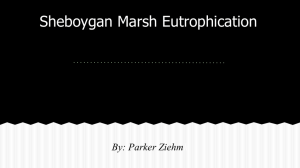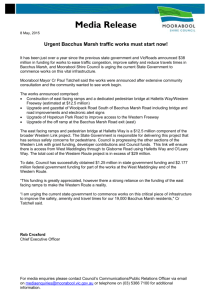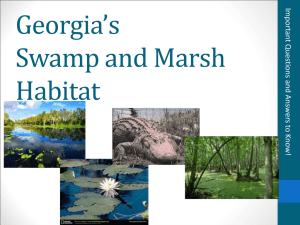Lesson 24
advertisement
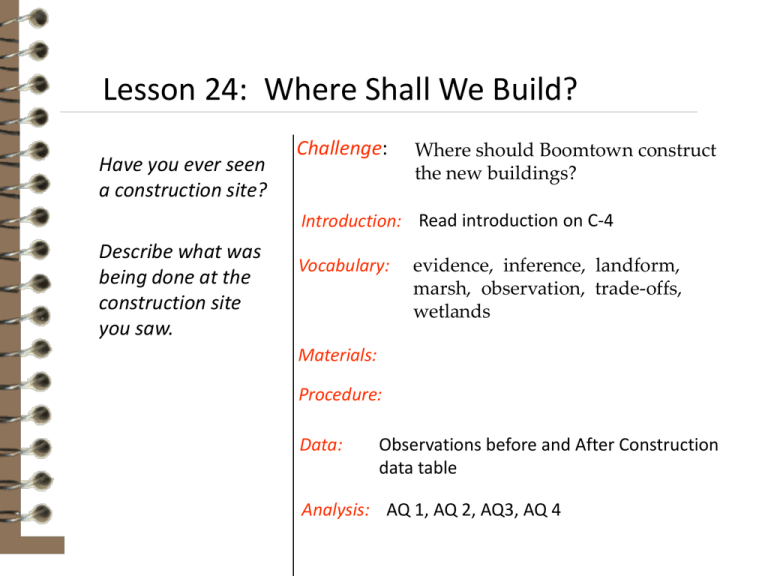
Lesson 24: Where Shall We Build? Have you ever seen a construction site? Challenge: Where should Boomtown construct the new buildings? Introduction: Read introduction on C-4 Describe what was being done at the construction site you saw. Vocabulary: evidence, inference, landform, marsh, observation, trade-offs, wetlands Materials: Procedure: Data: Observations before and After Construction data table Analysis: AQ 1, AQ 2, AQ3, AQ 4 Scenario There is a need for new homes in the rapidly growing community of Boomtown. Explain that there are three possible sites being considered for construction Physical shapes such as hillsides, cliffs, and marshes are called: Landforms hillsides cliffs marshes Marsh A marsh is an example of a “Wetland”. A wetland is an area made up mostly of water and watery land. A marsh is wetland area dominated by grasses. An example of a wetland that is different then a marsh is a swamp. A marsh is dominated by grasses. A swamp is dominated by trees. What are some examples of local wetlands? Smith and Bybee lake The Columbia Slough The photographs in Figure 1 in the Student Book shows examples of three kinds of locations being considered— hillsides, wetlands, and seaside cliffs—both before and after construction. These are not before and after photographs of Boomtown, since Boomtown is still in the process of deciding where to build. In fact, none of the photographs are of the same place nor are they taken from the same perspective. Directions 1. Each Group uses the 4-2-1 approach : 2. Students should work in pairs to study the photographs. 3. Then students will meet in groups of four to further discuss their ideas and review their observations. The Recorder must record the groups results on a data table given to him/her to be shared with the class and then turned in to Mr. Saulter 4. Each student will then create a data table to fill out and answer the questions at the end of the activity individually. Marsh Hillside Cliff Directions 1. Each Group uses the 4-2-1 approach : 2. Students should work in pairs to study the photographs. 3. Then students will meet in groups of four to further discuss their ideas and review their observations. The Recorder must record the groups results on a blank sheet of paper to be shared with the class and then turned in to Mr. Saulter 4. Each student will then be given a data table to fill out and answer the questions at th end of the activity individually. What is the difference between scientific observations and inferences? observations Descriptions or measurements gathered by the senses. What we can see directly in the photographs. We may observe that the wetlands have been filled in and have less water. Inferences The conclusions we make based on what we see. From this, we may infer that this has been bad for wildlife in the area While this inference is a possibility, the only way to be certain would be to look at the actual situation and see if the wildlife has suffered as a result. Directions 1. Each Group uses the 4-2-1 approach : 2. Students should work in pairs to study the photographs. 3. Then students will meet in groups of four to further discuss their ideas and review their observations. The Recorder must record the groups results on a blank sheet of paper to be shared with the class and then turned in to Mr. Saulter 4. Each student will then be given a data table to fill out and answer the questions at th end of the activity individually. Sample Observations Before and After Construction Appearance Before Construction Appearance After Construction Marsh Lots of water and birds. Full of grasses, reeds, and some trees. Land area looks swampy. Very flat and dry. Some trees and grass. No water visible. No birds visible. Lots of houses and concrete. Trees and grass are present, but different kinds than before Hillside Covered with trees and grass. Hills have ridges and valleys. Houses, roads, and cars. Less grass, fewer trees, soil churned up in some places. Some areas are leveled. Cliff Sandy and rocky on the sides of cliff. Some vegetation on the top. Small overhang at top. Barriers built in front of shore. Looks unstable. House on top of cliff. Sandy and rocky sides with more overhang Less vegetation on top. Coastline is not as straight as before Analysis Question 1 Marshes hills, and cliffs are three kinds of landforms. A landform is any characteristic physical shape of the earth’s surface. Make a list of some other familiar landforms that you can think of that aren’t mentioned in this activity. 1. valleys 2. canyons 3. plateaus 4. mountains, 5. buttes 6. mesas 7. stone arches Analysis Question 2 Explain how each of the following places was either changed or was not changed by the construction of buildings: a. marsh The marsh was changed because there is no longer any water in the area. The ground has become solid instead of marshy. There are no birds to be seen and the grasses and trees were replaced with species that are not originally from the area. There doesn’t appear to be anything that hasn’t been changed as a result of building at this site. Analysis Question 2 Explain how each of the following places was either changed or was not changed by the construction of buildings: b. hillside The hillside was changed because the trees were cut down and replaced with roads and houses. The earth surface has fewer peaks and valleys after building. The area outside of the immediate area does not seem to be changed. Analysis Question 3 Based on what you know so far, on which site do you think Boomtown should build houses? Explain, using the observations that formed your opinion. Example: a student might say that Boomtown should build homes on the marsh, because the marsh was unattractive and that after construction the marsh is filled in with firm soil. Analysis Question 4 Explain how the following information about the Delta Marsh, Green Hill, and Seaside Cliffs could help the council make the decision about where to build the new housing. a. weather Rainfall - heavy rain could wash away the hills or the cliff and could flood the wetlands. b. animals The birds seen in the photos of the wetlands, could be endangered if the construction destroys or significantly changes the habitat needed for them to live. Analysis Question 4 Explain how the following information about the Delta Marsh, Green Hill, and Seaside Cliffs could help the council make the decision about where to build the new housing. c. plants Plants may also be endangered or at least made scarce locally. Plants, like those found at the top of the cliff, help prevent erosion because they absorb water and because their roots stabilize the earth. Analysis Question 4 d. housing prices Housing prices could go down if there is more housing available, or if the construction makes the area less attractive. e. shape of the land Some landforms are difficult to build on, such as a very steep slope. Some places are not safe to build on, such as an area that will flood.
